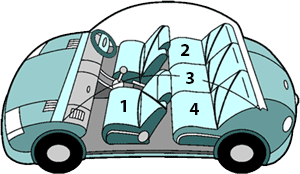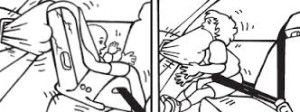Home » babies in cars » How much do you love your child?
How much do you love your child?
- Nov, 22, 2015
- Adrienne
- babies in cars, Child safety, Parenting
- 12 Comments.
Last week I wrote about keeping children safe in shopping malls due to the rash of attempted kidnappings in the Pretoria and Centurion areas.
This week I need to write about one of my pet peeves. With over 25 years of nursing experience, some of it in an emergency department, 5 years working as a volunteer medic, teaching CPR and First Aid and being the mother of 4 children, I feel I have the experience to talk about this thing that I hate.
I know I will annoy some people reading this post, and probably lose some followers, but it is too important a topic to tiptoe around. This will be a long post with very few pictures. The pictures that are included may upset the more sensitive readers.
Every single time you DO NOT strap your child into the correct restraints when you take them out in the car, you endanger your child’s life!
Why? Is it because the crying is too much, or you are running late, or even that your child hates the car seat?
South Africa has one of the highest road death tolls per capita in the world! Last year, December to January, statistics stated that nearly 1500 people died in road accidents. Just this year over the Easter break we had 287 reported road deaths.
Speak to almost any medic and they will tell you their worst calls almost always involve injured or dead children.
As of May 2015, a long overdue law was introduced. This requires South Africans to install car seats for babies and toddlers. Road accidents cause the most injury related deaths among the under-five age group.

In 2013 the Medical Research Council released results of a study which stated that road accidents cause around 50% of non-natural, or injury related deaths among under-fives.
There is a wonderful group called “Compassionate Friends” and, sadly, their mandate is to counsel parents who have lost a child. This is their mission statement.
“THE COMPASSIONATE FRIENDS is a mutual self-help organisation offering friendship and understanding to bereaved parents and siblings.
The primary purpose is to assist them in the positive resolution of the grief experienced upon the death of a child and to support their efforts to achieve physical and emotional health.
The secondary purpose is to provide information and education about bereaved parents and siblings. The objective is to help those in their community, including family, friends, employers, co-workers and professionals to be supportive.”
Putting your child into the correct sized car seat, or booster seat, is one of the simplest ways to save your child’s life. One doctor went so far as to say that he felt that parents who do not insist on their children wearing seatbelts, are actually being neglectful.
“Studies in the United States have shown that wearing seatbelts could have prevented 75 percent of injuries in children under the age of four, and 50 percent in children aged four to 12,” said the head of the emergency and trauma unit at St Dominic’s Hospital, Dr Jeanne-Marie van der Westhuizen.
“We are failing our children by not enforcing the law that is there, by not using common sense and by not teaching our children to buckle up.”
Buckling children in age- and size-appropriate car seats, booster seats and seat belts, reduces the risk of serious and fatal injuries:
- Car seat use reduces the risk of death to infants (aged <1 year) by 71%; and to toddlers (aged 1–4 years) by 54% in passenger vehicles.2
- Booster seat use reduces the risk for serious injury by 45% for children aged 4–8 years when compared with seat belt use alone.3
- For older children and adults, seat belt use reduces the risk for death and serious injury by approximately half.4
My children learned very quickly, and from an early age, that the wearing of seat belts was non- negotiable. I drive around and see moms with 7 seater cars and yet the children are standing up between the seats! Kids are in the back climbing all over each other. What happens if you need to brake suddenly as the taxi pulls in front of you?
What is the correct place to put your baby? The middle back seat is the safest place for the most vulnerable. Children 1 year and under should be facing the rear to reduce the risk of spinal injury, in the event of an accident. If the child is still under the maximum weight stated on the car seat (check the back for the label) then keep them rear facing for longer. You can change the child to a booster seat when the child is 4 years old or weighs 18kg or more. The front seat should only be for children over the age of 12 years.

The airbag, which is designed to save our lives, can actually cause major injuries to children who are sitting in the front.

Seatbelt harnesses and adjusters are available online, they allow seatbelts to be made more comfortable for children, putting a belt under the arm can also cause major injury when you come to a sudden stop.
When you stop suddenly and the child is not properly restrained, they can either fly through your windscreen or hit the back of the driver or passenger seat and injury their face or worse.

Sorry to be blunt but children sitting on parents laps are, unfortunately, your airbag! If you are in an accident they will be caught between your dashboard and you, especially if you are wearing your seat belt and they are not.
There was an advert many years ago on an M1 billboard that had two pictures. One had a child sitting restrained in a car seat with the heading she loves me and the second picture was of the same child sitting on their own in the back seat with no child seat, only toys and it said “she loves me not”. Obviously the advert wasn’t up long but to me it was a pertinent advert.
I asked my friend and paramedic lecturer his opinion, Damian Taylor is an Advanced Life Support Paramedic, working on helicopter rescue as well as in the road, he is also the principal of the HELP EMT academy in Johannesburg, where I studied and taught first aid and CPR. This is his quote “as a pre-hospital intensive care paramedic, I have attended many motor vehicle and motorcycle collision scenes in which children were involved, and where those children suffered severe, debilitating injuries and more often where children died from their injuries, simply owing to the lack of use of readily available children safety equipment for the motorcar and motorcycle. All children under the age of 8 years old should have a size appropriate booster car seat available for each child (a baby seat facing the correct direction on installation is required for small children and infants). These seats should be secured following the manufacturers guidelines and when the motorcar is in motion, all children should be well secured in these seats – only being unfastened when the journey has ended.” Children should ideally NOT be transported on a motorcycle and if this is absolutely necessary, all necessary safety equipment as is worn by the adult driver must be mad available to the child passenger – including protective clothing, an appropriately sized helmet (rated for motorcycle safety). The child passenger must also have the necessary booster seat for the motorcycle and the ability to fix the booster seat onto the motorcycle and then safely strap the child passenger onto the seat. Infants should not under any circumstances be transported on a motorcycle, regardless of the safety measures one has taken to protect the infant.
Children and infants not properly secured in motorized transportation become “free floating objects” in the event of a motor vehicle accident and will be subject to the physical laws of motion. Any unrestrained objects in a car during a motor vehicle crash will fly forward into the front section of the vehicle during sudden deceleration and will be thrown with significant force (significant enough to cause death), against the dashboard and front windscreen. Infants held in their parents or caregivers arms while they sit in the motor vehicle seats simply become “portable airbags” as they will be crushed between the dashboard/windscreen and the person holding the infant. The infant or child may even be ejected from the vehicle during the accident, which increases the risk of sustaining a fatal injury by up to 50%)
Think before you drive with unrestrained children and infants – mistakes made on that journey, could make that journey, their last…”
I end this by saying that no child ever died from crying but more than one has died from injuries sustained during an accident.
Love your children. Keep them safe.
- accident prevention
- App reviews
- babies in cars
- Books
- Braai
- Bread Recipes
- budget gifts
- Budgeting
- Budgeting in South Africa
- calendar
- Celebrations
- Cellphone safety
- Chanuakah
- Chicken recipes
- Child safety
- Children
- Chrismukah
- Christmas gifts
- Daily budgeting for South Africans
- Debt
- distracted driving
- driver safety
- drowning
- Environmental Issues
- Family
- Family Calendar
- Finance
- food
- Food for toddlers
- Food Myths
- Freedom Day
- frugal gifts
- grocery shopping
- Health
- heat exhaustion
- Heat wave
- Heritage Day
- household management
- I -Plan
- I-cook
- Jewish food
- JOFR
- Johannesburg
- Kosher
- Lockdown
- Managing your household
- Meal Planning
- Meat Recipes
- monthly shopping
- Nurses Day
- Obesity
- online shopping
- Organisation and clean up
- Parenting
- personal finance
- Personal safety
- pets in cars
- Public Holidays
- Quick meals
- Random Ruminating
- Recipes
- Religious holidays
- Reviews
- saving money
- School
- slow cooker
- Slow cooker recipes
- Soup
- South African
- Specifically Jewish
- Summer
- Teenagers
- textbooks
- texting
- Tu B Av
- Uncategorized
- Vegetarian Recipes
- Winter
- Workers Day
- workshop
- Xmas gifts
- September 2025
- May 2025
- November 2023
- October 2022
- August 2021
- February 2021
- January 2021
- November 2020
- September 2020
- August 2020
- June 2020
- May 2020
- April 2020
- March 2020
- February 2020
- January 2020
- November 2019
- October 2019
- September 2019
- August 2019
- May 2019
- April 2019
- February 2019
- January 2019
- November 2018
- October 2018
- September 2018
- May 2018
- April 2018
- March 2018
- February 2018
- January 2018
- August 2017
- May 2017
- April 2017
- March 2017
- February 2017
- January 2017
- December 2016
- October 2016
- September 2016
- August 2016
- July 2016
- May 2016
- April 2016
- March 2016
- February 2016
- January 2016
- December 2015
- November 2015
- October 2015
- September 2015
- August 2015
- July 2015
- June 2015

Leave a Reply